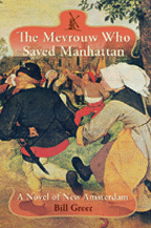Bill's Brownstone
Wander through New York's Past and Present with
the author of The Mevrouw Who Saved Manhattan
Dutch Days
"People ought to give [Director Kieft] a letter of recommendation to Master Gerrit, and I'll send a pound Flemish that he should die like a nobleman."
- Hendrick Kip in 1643 suggesting the current Director-General be sent to the public executioner of Amsterdam. The pound Flemish would buy a condemned man an axe instead of a rope.
Hendrick Kip was one of the more colorful characters living along Bridge Street, so named for the bridge over the ditch flowing out of Blommaert's Vly, a bog lying about where the New York Stock Exchange sits today. The ditch was later widened into a canal running along Broad Street. Kip had no more admiration for the next Director-General, Peter Stuyvesant. He signed the Remonstrance sent to their High Mightinesses the States General who ruled the Netherlands, begging that Stuyvesant be recalled. Today he lends his name to Kip's Bay, an area in the East Thirties along the East River.
Anthony van Salee, known as the Turk, and his wife Griet Reyniers, also made Bridge Street their home until they were banished from Manhattan. Van Salee took his real name from his Dutch father, who admiraled a sultan's fleet. His nickname came from the Moroccan woman the admiral bedded. Griet was perhaps Manhattan's first whore, known for measuring manliness with a broomstick. In a case of the pot calling the kettle black, she called the wife of the Reverend Everardus Borgardus a whore for lifting her skirt. When witnesses testified the poor woman was only holding her hem out of the mud, Director Kieft banished the couple to Long Island, but he kindly gave them two hundred acres of waterfront farmland so they could support the babe growing in Griet's belly.
Bridge Street also claims the home of Manhattan's first recorded suicide. Apparently distraught over fines for serving beer past curfew, tavernkeeper Hendrick Smits hanged himself from a tree in 1664. The schout, a combination of sheriff and prosecutor, ordered that the corpse be drawn on a hurdle as an example and terror to others considering such a fate for themselves. But the town fathers heeded the people's petition that the poor man be buried in the Church yard.
Bill's Book
The Mevrouw Who
Saved Manhattan
A Novel of New Amsterdam
like etchings by
Van Ostade and Steen."
-- Charles Wendell, Ph.D.,
President of the
New Netherland Institute

on a madcap ride through
New York history.
More about the book.
Amazon
for the Kindle
and the Nook
and see what you think
laughing out loud."
right on the money."
better ... toward a
highly satisfying resolution."